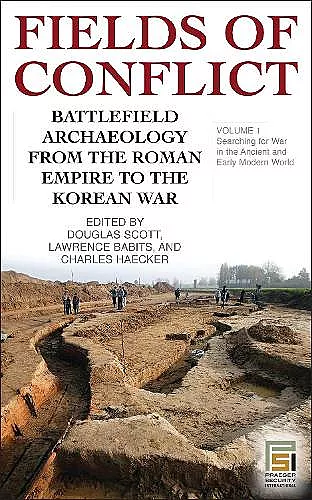Fields of Conflict
Battlefield Archaeology from the Roman Empire to the Korean War [2 volumes]
Douglas Scott editor Lawrence Babits editor Charles Haecker editor
Format:Set / collection
Publisher:Bloomsbury Publishing PLC
Published:30th Nov '06
Should be back in stock very soon

Battlefield archaeology is a crucial tool for understanding how battles are fought and won both in the past and today, often revealing shocking conclusions at odds with the documentary record, and helping families find information about lost loved ones who fell.
Battlefield archaeology is a crucial tool for understanding how battles are fought and won. This two-volume guide to battlefield archaeology shows the reader how to identify a battlefield from earthworks and particular artefacts, examining some of the best preserved battlefields in the world, from the ancient world to World Wars I and II.To the world, battlefields represent sites of international conflict, places where the courseof history is decided. On a national level, battlefields are places of pride and community identity, where the sacrifice and courage of those who fought take on mythic status. Battlefield archaeology is a crucial tool for understanding how battles are fought and won, often revealing shocking conclusions at odds with the documentary record. Nothing shows the effects of strategies and tactics better than the evidence in the ground-physical evidence shows whether battle plans succeeded or failed and the effectiveness of planning versus luck. The editors of Fields of Conflict explore the ways in which battlefield archaeology clarifies our understanding of military tactics and strategy as they have evolved over the last 2000 years. In two volumes, they not only reveal new interpretations of classic battles, but show clearly how archaeology can be used regardless of geographic or temporal location, making this an ideal book for general reader and professional archaeologist or soldier alike. First showing the reader how to identify a battlefield from earthworks and particular artifacts, the authors then foster a new understanding of warfare by examining some of the best preserved battlefields in the world. From the ancient world, through the Middle Ages to World Wars I and II and the Korean war, the analysis of what gets left behind at the close of epic struggles shows all too painfully how men fought and died, and how decisions made by commanders shaped history even today. Yet more than history, battlefield archaeology can be deeply meaningful to relatives of soldiers today, who seek to know where their missing loved ones fought, died, and were possibly buried. While military archaeology has always been popular, this set is the first attempt to create a cohesive chronological interpretation for future study and understanding.
Twenty-four articles in two volumes on the archaeology and significance of battlefield research are ground truthing the written record of particular battles. Introductory articles define battlefield archaeology and its methodology, theoretical basis, and focus on the landscape….These articles not only enhance the documentary record, but also provide significant new data on the battles' ebb and flow and tactics that do not exist in the written record, thus reinterpreting, in many cases, the course of the action. Recommended. All levels/libraries. * Choice *
Suitable for graduate libraries. * Library Journal *
The editors…explore the ways in which battlefield archaeology clarifies our understanding of military tactics and strategy as they have evolved over the last 2,000 years. In two volumes, they not only reveal new interpretations of classic battles, but show clearly how achaeology can be used regardless of geographic or temporal location, making this an ideal set for the general reader and professional archaeologist or soldier alike. * Lt. Colonel Robert A. Lynn, Florida Guard *
ISBN: 9780275993153
Dimensions: unknown
Weight: 992g
480 pages